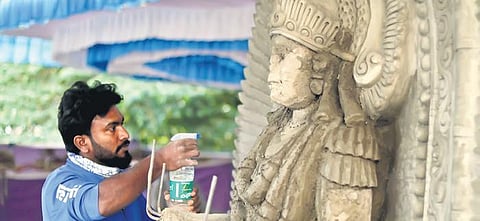

SHIVAMOGGA: You would look at cement as something grey and dull and of walls or structures. But in the right hands, it can turn into an evocative work of art. One of the most famous examples of a cement sculpture in Karnataka is the statue of Lord Shiva in Murdeshwar. Although traditional materials dominate the sculpting world, an increasing number of artists in Karnataka have begun to work with mediums such as cement, and are becoming a bridge between the old and the new.
Karnataka has around 1,500 artists who create both traditional and contemporary works, that is, they work with the traditional mediums of stone, metal, and wood, but also with late entrants to the art world such as cement. Factors such as lack of availability of materials have also nudged artists towards cement, says Veeranna M Arkasali, chairman of the Karnataka Shilpakala Academy. In a career spanning 35 years, he has worked with all three major traditional mediums.
Finding the right kind and quantity of stone or wood could take months, whereas sourcing cement is a matter of locating the nearest shop, says Veeranna. Another reason for its popularity is that it is relatively easier to work with, in terms of procuring the adequate quantity, and shaping it to the form envisioned by the artist. It is also much easier to rectify mistakes compared to wood, stone and metal sculptures, says Veeranna. It also helps that cement pieces are relatively lower priced, says Vipin Bhadauria, artist and Shivamogga district director of the Academy.
The market price of a wood or stone statue is prohibitive. A basic five-foot sculpture made of either material could cost around Rs 80,000, while one of medium quality would be around Rs 1.5-2 lakh. High quality work would easily set you back around Rs 4-5 lakh, says Vipin. “I chose sculpting because I found a satisfying way to grow as an artist and express the talent I have to lead an independent and happy life,” says Hinkal-based Basavaraja.
He slowly fell in love with sculpting while studying for a postgraduate degree in Fine Arts at Chamarajendra Academy of Visual Arts. He often gets orders from the government or other organisations to create work with a social message. Some of his subjects include creating murals opposing female infanticide and education people about it, sensitising the public about people living with HIV/AIDS, statues of people such as B R Ambedkar. He sculpts with cement, stone, fibre, and even does clay modelling. “Our work gets recognised by people, which gives us happiness. Dedication, interest, and hard work is all that you need to create a good sculpture,” Basavaraja says.
HOW IT’S DONE
A cement sculpture is essentially made of concrete: a mixture of gravel, sand, water, and cement, which acts as a binding agent. To start with, the sculptor creates the armature - the skeletal frame - with brick pieces and uses it as a guide to flesh out the statue, Vipin explains. Since the concrete mix needs to be used when it is still paste form, sculptors need to work fast. Also, it is challenging as it has to be shaped and detailed with bare hands, while it is still wet. Artists largely use grade 43 cement for the bulk of the work, as it is less toxic than grade 53 cement. Grade 53 cement could seriously harm the skin, Vipin adds.
“Curing is the most important part of sculpting,” says Basavaraj. Curing is the process by which cement hardens under appropriate moisture and temperature conditions, and affects the durability of the sculpture. If not done right, the concrete can develop cracks or other problems. Grade 53 cement is used for curing. “We use marble powder mixed with cement to prevent cracks, to make it more durable,” Basavaraj says. At around 50 years, cement sculpture has a shorter life than its metal or stone counterparts. But 50 years still a generation that can experience the delight that comes from a work of art.
For the love of art
Karnataka Shilpakala Academy organises training camps across the state to encourage and identify sculptors of stone, cement and wood. Recently the academy organized a cement training camp at Shivamogga. Sculptors from Bengaluru, Mysuru, Chitradurga, Belagavi, Bagalkot, Kalaburagi, Yadgir, Raichur and Haveri had participated in the camp.